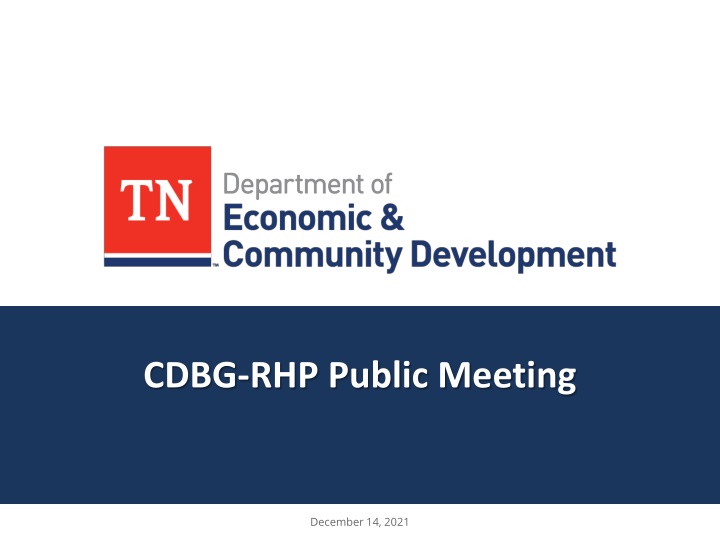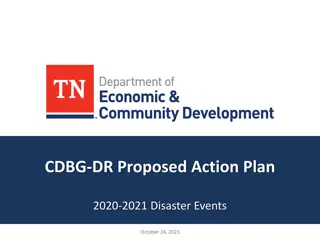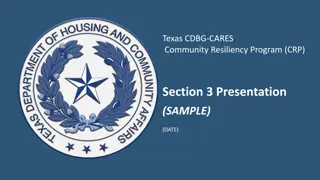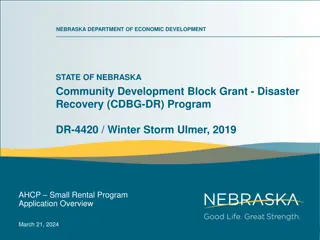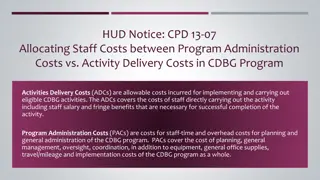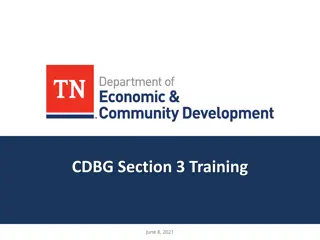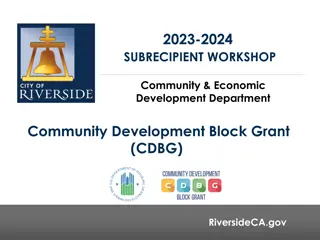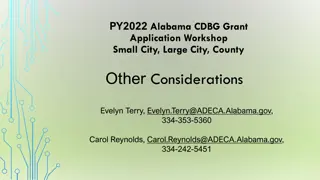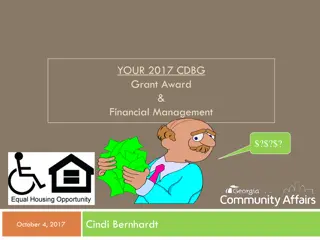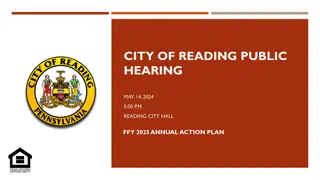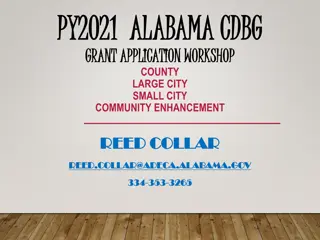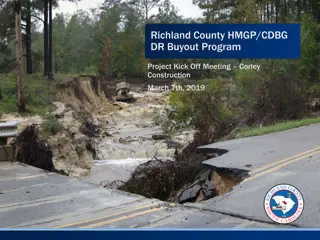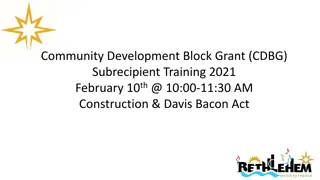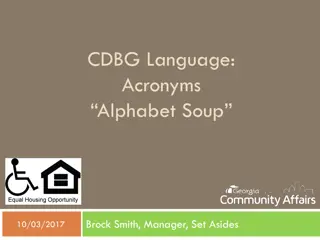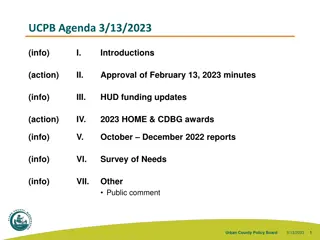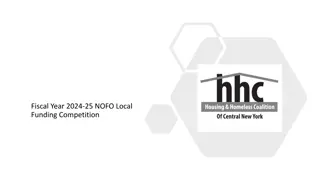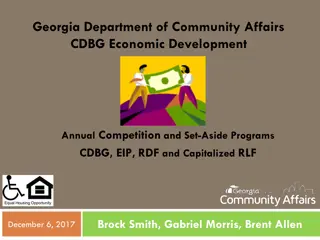CDBG-RHP Public Meeting Overview for Funding Assistance
Providing insights into the CDBG-RHP program, this overview covers funding authorization, program intent, available grants, eligible uses of funds, and subrecipient criteria. Learn about the allocation of funds, intended benefits for individuals recovering from substance use disorders, and guidelines for grant distribution and eligibility.
Download Presentation

Please find below an Image/Link to download the presentation.
The content on the website is provided AS IS for your information and personal use only. It may not be sold, licensed, or shared on other websites without obtaining consent from the author.If you encounter any issues during the download, it is possible that the publisher has removed the file from their server.
You are allowed to download the files provided on this website for personal or commercial use, subject to the condition that they are used lawfully. All files are the property of their respective owners.
The content on the website is provided AS IS for your information and personal use only. It may not be sold, licensed, or shared on other websites without obtaining consent from the author.
E N D
Presentation Transcript
CDBG-RHP Public Meeting December 14, 2021
CDBG-RHP Overview Authorized under Section 8071 of the SUPPORT for Patients and Communities Act Authorization is good for 5 years FY20 and FY21 have been funded FY20 - $891,000 FY21 - $889,092 Based on the rules and requirements of CDBG
Program Intent CDBG-RHP is specifically intended to provide stable, temporary housing to individuals in recovery from a substance use disorder. Temporary housing assistance is defined as 2 years or less per individual or until the individual secures permanent housing, whichever is earlier.
Funding and Distribution Total available funding for grants: $1,691,088 Minimum Grant: $250,000 Maximum Grant:$750,000 Distributed based on a competitive application Will also consider geographic location of applicants
Eligible Uses of Funds Public Facility Improvements Acquisition of Real Property Lease, Rent & Utilities RHP cannot supplant funds that previously covered for an individual. New or Expanded Service that have been above and beyond the last 12 months. Assistance can be provided for up to 2 years or until the individual secures permanent housing, whichever is earlier. Rehabilitation and Reconstruction Single Unit publicly or privately owned residential building(s) Multi-Unit (up to 7 units) - publicly or privately owned residential building(s) Public Housing owned or operated by a public housing authority. Disposition of Real Property Acquisition Clearance and Demolition New Construction
Ineligible Uses of Funds Programming/Services Staffing Operations and Management
Eligible Subrecipients City and County governments are the only eligible subrecipients of the CDBG-RHP funds CDBG Entitlement jurisdictions are eligible for CDBG-RHP Must have a partnership/agreement with an established organization that currently operates in the recovery housing space provides/manages transitional housing for persons in recovery from a substance use disorder provides/manages permanent housing for persons in recovery from a substance use disorder provides/manages other forms of temporary supportive housing for persons in recovery from a substance use disorder
National Objective All CDBG-funded activities must meet a National Objective as defined in 24 CFR 570.483 HUD has issued a waiver that beneficiaries of CDBG-RHP can be presumed as low and moderate income or LMI. This waiver does not extend to other CDBG funds that may be part of the project.
Evaluation Criteria Criteria Project Need (100) County Fatal overdose rate (TDH) County Non-fatal overdose rate (TDH) County poverty rate (Census/ACS) Explanation of need of population served Points 20 20 20 40 Project Impact (100) Readiness (planning, design, shovel-ready, additional funding availability, etc.) Community support Explanation of supportive programs provided Project located in an Opportunity Zone 35 20 35 10 Project Feasibility (100) Timeline Sustainability Budget Leveraged Funds Prior experience (with TDMHSAS and/or TNECD programs, with Recovery Housing programs, with construction projects) Organizational Capacity and Partnerships 15 20 10 10 25 20 Total 300
Anticipated Outcomes All applicants will have to provide anticipated outcomes at the time of application and report on those outcomes annually, up to 1 year after the closeout of the project. Anticipated outcomes: Individuals Assisted with Transitional Housing Individuals Transitioned to Permanent Housing Transitional Housing Units Created Transitional Housing Units Improved
Expenditure Plan 30% of CDBG-RHP funds must be used within a year of the date of HUD s agreement with TNECD. This will likely be mid-January All funds must be expended by September 1, 2027. Applicants must be able to address both deadlines in the application.
Subrecipient Monitoring Standard CDBG rules and regulations will apply Environmental review, labor standards, procurement, etc. Refer to the CDBG Program Manual All grantees will receive at least 1 on-site monitoring Reporting Quarterly status reports Annual status and performance reports Closeout report 1 Year post-closeout performance report
Timeline Application will be available mid-January Will be posted on website (https://www.tn.gov/ecd/community- development-block-grant/cdbg/cdbg-rhp.html) Applications due March 11 Awards issued by April 1 Administration, Environmental Review, and Engineering/Architectural design can begin after award will contracting is taking place
Application Process Flow 1. Public Meeting * 2. Professional Services Procurement 3. Engineering document and cost estimate 4. Execution of resolution 5. Submission of application * Public meeting ads should be published at least 14 days prior to the public meeting
Kent Archer (615) 354-3591 kent.archer@tn.gov
